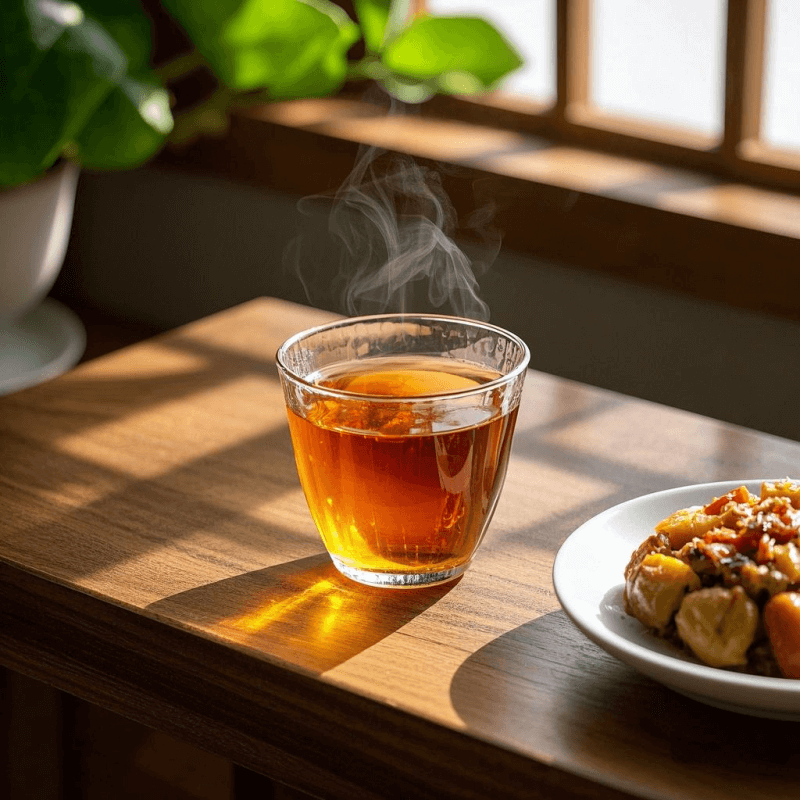Why People Reach for Oolong Now
Walk into any office break room or scroll through wellness TikTok, and you’ll likely encounter someone sipping oolong tea while claiming it’s their secret to better digestion or afternoon focus.
The post-meal cup has become a ritual for many seeking comfort after heavy foods, while others swear by oolong’s ability to provide calm alertness without coffee’s intensity.
Social media buzz has amplified interest in oolong tea benefits, but it’s also created confusion. Claims about “instant fat burning” or “miracle metabolism boosting” don’t match the more subtle, gradual effects most people actually experience. Real users are drawn to oolong for practical reasons: it settles the stomach after rich meals, provides gentle energy during afternoon slumps, and offers a soothing evening routine that doesn’t interfere with sleep.
A Benefits Map You Can Trust

Research on oolong tea reveals a spectrum of evidence ranging from well-supported to promising but preliminary.
Established Benefits
- Antioxidants and cardiovascular support: studies consistently show oolong’s polyphenols can help reduce inflammation and support heart health.
Promising but Modest
- Weight management: oolong may slightly increase fat oxidation and support healthy blood sugar regulation, but these effects work gradually and complement—rather than replace—healthy lifestyle choices.
Emerging Research
- Gut health: preliminary studies indicate oolong’s compounds may promote beneficial bacteria growth, but more human trials are needed to confirm digestive advantages.
Digestion & “Feel-Lighter” Days
Many people discover oolong through its reputation for easing post-meal heaviness, particularly after fatty or rich foods.
- Best timing: 30–60 minutes after eating.
- Why it helps: polyphenols may aid fat digestion; mild astringency provides a cleansing sensation.
- Caution: avoid drinking oolong immediately before meals, as tannins can interfere with iron absorption.
Focus Without the Jitters
Calm Alertness Explained
The combination of caffeine and L-theanine in oolong creates what researchers call “calm alertness”—mental clarity without the anxiety or crash associated with coffee.
- Caffeine content: ~30–50mg per cup.
- Effect: enough stimulation to enhance focus; L-theanine balances potential jitters.
Afternoon Coffee Alternative
Oolong is an excellent substitute for 2–3 PM coffee. The mindful brewing process itself can refresh focus and provide a break in workflow.
Dose, Timing, and Frequency
- Daily intake: 2–3 cups (200–300ml each).
- Timing: morning and early afternoon are ideal.
- Cut-off: finish last cup at least 2–3 hours before bedtime.
- Tip: adjust based on your sensitivity to caffeine.
Brew Like You Mean It
Brewing Guidelines
- Water temperature: 185–205°F (90–95°C).
- Steeping time: 1.5–3 minutes for the first infusion.
- Leaf amount: 1 teaspoon loose leaf per cup.
Multiple Infusions
High-quality oolong can be re-steeped several times, with each infusion unlocking different flavors and compounds.
Avoid over-extraction: too much steeping can cause bitterness and digestive upset.
Keep the Good Stuff: Home Storage That Actually Works
- Store in airtight containers, away from light, heat, and moisture.
- Shelf life: up to 2–3 years unopened; best used within 6–12 months after opening.
- Warning signs: musty odors, flat taste, or loss of aroma.
Safety Flags & Who Should Pass
- Pregnant/nursing women: limit total caffeine.
- Anxiety disorders: even moderate caffeine may be problematic.
- Gastritis or acid reflux: drink with food, not on an empty stomach.
- Iron deficiency: avoid drinking oolong with iron-rich meals.
Case Notes: Real-World Applications
Case 1: The Afternoon Brain Fog Solution

Sarah, a graphic designer, replaced her 3 PM coffee with oolong. She brewed at 90°C for 2 minutes and found sustained focus without the late-day crash. Sleep quality improved after one week.
Case 2: Post-Meal Comfort in a Food-Rich Culture
James, living in a region with heavy cuisine, began drinking oolong 45 minutes after dinner. Over two weeks, he felt lighter after meals and transitioned more easily into evening activities.
FAQ
How long before I see weight management benefits?
Subtle changes in digestion/energy: 1–2 weeks. Weight-related effects: 2–3 months with consistent use.
Is oolong better than green tea for health?
Both have unique benefits—green tea has more catechins, oolong has theaflavins. Choose based on taste and timing.
Should I drink it before or after meals?
Best after meals (30–60 minutes), not before.
Are tea bags as effective as loose leaf?
Loose leaf is generally higher quality, but reputable tea bags still work.
Can I add honey or milk?
Yes, in small amounts, but pure brewing preserves maximum antioxidants.
